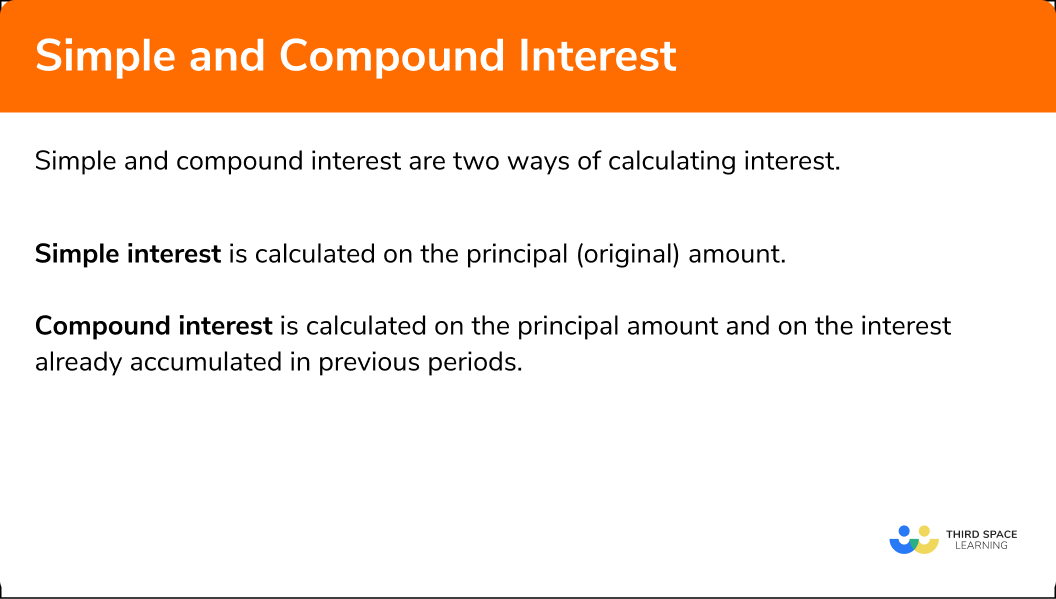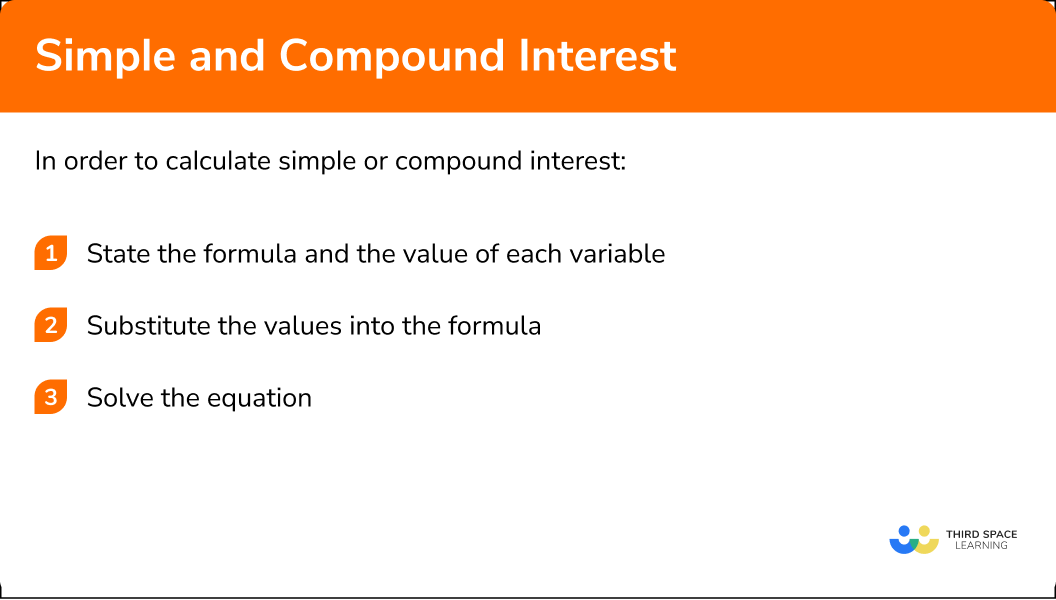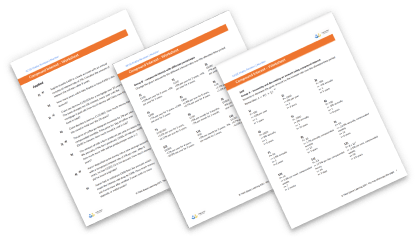One to one maths interventions built for KS4 success
Weekly online one to one GCSE maths revision lessons now available
In order to access this I need to be confident with:
Converting percentages to decimals Substitution Laws of indices Percentage change Calculator skillsThis topic is relevant for:

Simple Interest And Compound Interest
Here is everything you need to know about simple and compound interest for GCSE maths (Edexcel, AQA and OCR). You’ll learn how to calculate simple and compound interest for increasing and decreasing values, and set-up, solve and interpret growth and decay problems.
Look out for the simple & compound interest worksheets and exam questions at the end.
What are simple interest and compound interest?
Simple and compound interest are two ways of calculating interest:
Simple interest is calculated on the original (principal) amount, whereas compound interest is calculated on the original amount and on the interest already accumulated on it.
The difference between simple and compound interest is that simple interest is calculated using only the original amount whereas compound interest works out the interest on a previous amount as well.
The formula for calculating the simple interest earned on an investment is
A=PrtAnd we can calculate the value of the investment, A, after the time period with the formula:
\begin{aligned} A&=P+Prt \\\\ & =P\left( 1+rt \right) \end{aligned}The formula for calculating compound interest is:
A=P(1+\frac{r}{100})^{n}Where:
- I represents the simple interest
- A represents the final amount
- P represents the original principal amount
- r is the interest rate
- n represents the number of times the interest rate is applied
Check out the comparative example below to see the similarities and differences between the two forms of interest.
Step-by-step guide: Simple interest
Step-by-step guide: Compound interest
What are simple and compound interest?

How to work out simple and compound interest
In order to calculate simple or compound interest:
- State the formula and the value of each variable.
- Substitute the values into the formula.
- Solve the equation.
E.g
\bf{£100} is invested for \bf{3} years at \bf{2\%} per year. Find the final value.
Simple interest
A=P(1+rt) \
Here:
- P=100
- r=0.02 (as 2% = 0.02)
- t=3
Substituting these values into the simple interest formula
A=P(1+rt)
We get:
A = 100(1+0.02\times{3})\
A = 100(1+0.06)\
A = 100(1.06)\
A = 100\times{1.06}\
A = £106
Compound interest
A=P(1+\frac{r}{100})^{n} \
Here:
- P=100
- r=2
- n=3
Substituting these values into the compound interest formula
A=P(1+\frac{r}{100})^{n} \
We get:
A = 100(1+(\frac{2}{100})^{3}
A = 100(1+0.02)^3\
A = 100(1.02)^3\
A = 100 x 1.02^3\
A = £106.12
Simple and compound interest are used widely in real life, especially in financial mathematics for sale prices, borrowing money on a credit card or taking out a loan, the amount of money invested in the stock market and house prices to name a few.
Explain how to calculate simple or compound interest in 3 steps.

Depreciation
When the value of an asset reduces in price, it is known as depreciation.
Depreciation can be calculated the same way as compound interest but we must remember that the multiplier being used will be less than 1.
E.g
A car worth £20 \ 000 depreciates by 10\% per year for 2 years.
To find the value after 2 years we calculate using the multiplier of 0.9.
20 \ 000 \times 0.9^{2}=16 \ 200The car will be worth £16 \ 200.
Step-by-step guide: Depreciation

Simple interest and compound interest worksheet

Get your free simple and compound interest worksheet of 20+ questions and answers. Includes reasoning and applied questions.
DOWNLOAD FREE
Simple interest and compound interest worksheet

Get your free simple and compound interest worksheet of 20+ questions and answers. Includes reasoning and applied questions.
DOWNLOAD FREESimple and compound interest examples
Example 1: Simple Interest – Percentage Increase
£1500 is invested for 4 years at 5\% per year simple interest. What is the value of the investment after this time?
- State the formula and the value of each variable.
Here we use the formula A=P (1+rt) with:
- P=1500
- r=0.05
- t=4
2 Substitute the values into the formula.
Substituting these values into the simple interest formula A=P (1+rt) , we get:
A=1500(1+0.05\times{4})3 Solve the equation.
\begin{aligned} &A=1500(1+0.20)\\\\ &A=1500(1.20)\\\\ &A=1500\times{1.2}\\\\ &A=\pounds1800. \end{aligned}Example 2: Simple Interest – Percentage Decrease
A car is bought for £10,000 and loses 9\% of its value per year simple interest. What is the value of the car after 8 years?
State the formula and the value of each variable.
Here we use the formula A=P (1+rt) with:
- P=10000
- r=-0.09
- t=8
Substitute the values into the formula.
Substituting these values into the simple interest formula A=P (1+rt) , we get:
A=10000(1-0.09\times{8})
Solve the equation.
Example 3: Simple Interest – Different Time Scale
£7600 is invested for 2 years at 1\% per month simple interest. What is the value of the investment after this time?
State the formula and the value of each variable.
Here we use the formula A=P (1+rt) with:
- P=7600
- r=0.01
- t= 2 \times 12 = 24 (remember there are 12 months in 1 year)
Substitute the values into the formula.
Substituting these values into the simple interest formula A = P (1 + rt), we get:
A=7600(1+0.01\times{24})
Solve the equation.
Example 4: Compound Interest – Percentage Increase
£8500 is invested for 5 years into a bank account at 0.3\% per year compound interest. What is the value of the investment after this time?
State the formula and the value of each variable.
Here we use the formula A=P(1+\frac{r}{100})^{n} with:
- P=8500
- r=0.3
- n=5
Substitute the values into the formula.
Substituting these values into the compound interest formula A=P(1+\frac{r}{100})^{n}, we get:
A=8500(1+\frac{0.3}{100})^{5}
Solve the equation.
Example 5: Compound Interest – Percentage Decrease
A vacuum cleaner is bought for £399 and loses 22\% of its value per year compound interest. What is the value of the vacuum cleaner after 2 years?
State the formula and the value of each variable.
Here we use the formula A=P(1+\frac{r}{100})^{n} with:
- P=399
- r=-22
- n=2
Substitute the values into the formula.
Substituting these values into the compound interest formula A=P(1+\frac{r}{100})^{n}, we get:
A=399(1-\frac{22}{100})^{2}
Solve the equation.
Example 6: Compound Interest – Different Time Scale
A house is valued at £150,000. On average, the house price increases by 0.24\% per month over a period of 2.5 years compound interest. What is the value of the house after this time?
State the formula and the value of each variable.
This time the interest rate in monthly so we need to convert the time into months.
2.5 year is the same as 2.5\times 12 = 30 months.
Here we use the formula
A=P(1+\frac{r}{100})^{n} with:
- P=150000
- r=0.24
- n=30
Substitute the values into the formula.
Substituting these values into the compound interest formula A=P(1+\frac{r}{100})^{n}, we get:
A=150000(1+\frac{0.24}{100})^{30}
Solve the equation
Common misconceptions
- Applying the incorrect formula to the question
This is a very common mistake where the simple interest on an amount is calculated instead of using the compound interest formula.
- Incorrect percentage change due to different time scales
Here is example 6 with this misconception:
A house is valued at £150,000. On average, the house price increases by 2.4\% per month over a period of 2.5 years compound interest. What is the value of the house after this time?
Here we use the formula A=P(1+\frac{r}{100})^{n} with:
- P=150000
- r=0.24
- n=2.5
Although the answer here looks reasonable, the 0.24\% interest is per month not per year, which is what has been calculated.
- Using the incorrect value for the percentage change
Not dividing the percentage rate by 100 is a common error. For example when using compound interest to increase £100 by 2% for 5 years, this calculation is made:
\begin{aligned} &A=100(1+2)^{5}\\\\ &A=100\times{243}\\\\ &A=\pounds{24300} \end{aligned}- Is the value increasing or decreasing?
If a value is depreciating (going down), the value of r is negative whereas it is incorrectly used as a positive and so the answer will be larger than the original amount.
Simple and Compound Interest practice questions
1. The probability of a team winning their next three football matches is 65\% per match. What is the probability that they win all three matches?
Write your answer as a percentage.




We can write the percentage as a fraction and then apply the “and” rule from probability, so the probability is given by
\frac{65}{100} \times \frac{65}{100} \times \frac{65}{100}
This can be converted to a percentage afterwards.
2. The population of bees in a hive is expected to increase by 5\% per year simple interest.
The population of bees in the hive is approximately 56,000 .
Work out the population of bees after 3 years.




5\% of 56,000 is 2800 , so over the 3 years the population increases by 8,400 .
Adding 8,400 to 56,000 , we get 64,400 .
3. A bucket holds 25L of water. A hole in the bucket starts to leak water, losing 12\% every minute compound depreciation.
Calculate the total amount of water in the bucket after 10 minutes?




The original amount is 25 , the decrease is 12\% per minute compounded over 10 minutes, so our calculation is
\\A=25(1-0.12)^{10}\\
\\A=6.96\\
4. The height of an apple tree increases at an average rate of 1.6\% per month, compound interest.
The apple tree is currently 1m tall.
How tall will the apple tree be after 2 years?




The original amount is 1 , the increase is 1.6\% per month compounded over 24 months, so our calculation is
\\A=1(1+0.016)^{24}\\
\\\\A=1.46\\
5. The population of chickens on an island is estimated to be around 20,000 .
With few natural predators, the chicken population has exploded, increasing the population by 3.6\% per year simple interest.
Estimate how many chickens there are on the island after 15 years.




3.6\% of 20,000 is 720 , so over the 15 years the population increases by 10,800 .
Adding 10,800 to 20,000 , we get 30,800 .
6. A vintage car was valued at \pounds 650,000 5 years ago. For the first 3 years, the value of the car depreciates by 2\% every year, using compound interest.
After this, the value increases by 5\% per year for the next 2 years, using compound interest.
What is the current value of the car?




The starting amount is 650,000 . To begin with, there is a 2\% decrease per year compounded over 3 years, then a 5\% increase per year compounded over 2 years. This can be combined into one calculation, so
\\V=650000(1-0.02)^{3}(1+0.05)^{2}\\
\\V=674482\\
Simple and Compound Interest Exam Questions:
1. Ed invested \pounds 1500 into a savings account. It earned compound interest at an annual interest rate of 0.72\% for 5 years.
He wrote down how much money he would receive after 5 years. Here is his calculation:
1500\times{0.72}\times{5}=£5400
(a) What are the two mistakes that Ed has made?
- ________________________________________________
- ________________________________________________
(b) What amount would Ed have after 5 years?
(4 marks)
(a)
Ed has used simple interest.
(1)
Ed has not converted the percentage correctly ( 72\% interest).
(1)
(b)
1500 \times 1.0072^5
(1)
\pounds 1554.78(1)
2. In 2003 , the population of bats in a cave was approximately 20 million.
After 5 years, the population grew by 3\% every year, and then for the next 3 years, the population gradually declined by 2\% each year.
How many more bats are in that cave in 2011 . Write your answer in standard form to 3 significant figures.
(5 marks)
(1)
20,000,000 \times 1.03^5 \times 0.98^3 or 23185481.49 \times 0.98^3
(1)
21821990(1)
21,821,990-20,000,000=1821990(1)
1.82 \times 10^6(1)
3. (a) \pounds 30,000 is invested with an annual percentage rate of 0.1\% simple interest rate per month into Account A . How many months will it take for the investment to reach \pounds 31,200 ?
(b) Account B offers a compound interest rate of 1.5\% per year. Which account would provide the most interest after exactly 3 years?
(7 marks)
(a)
30,000 \times 0.001 = £30 (monthly payment)
(1)
31,200-30,000=£1200 interest
(1)
£1200 \ / \ 30 = 40 months
(1)
(b)
30,000 \times 1.015^3
(1)
£31370.35(1)
30,000 + (30 \times 36) = 31080(1)
Account B
(1)
Learning checklist
You have now learned how to:
- Solve problems involving percentage change, including: percentage increase, decrease and original value problems and simple interest in financial mathematics
- Set up, solve and interpret the answers in growth and decay problems, including compound interest (and work with general iterative processes)
The next lessons are
Still stuck?
Prepare your KS4 students for maths GCSEs success with Third Space Learning. Weekly online one to one GCSE maths revision lessons delivered by expert maths tutors.

Find out more about our GCSE maths tuition programme.